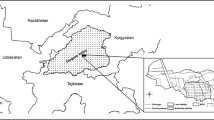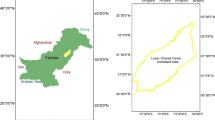Abstract
Capillary rise represents an often neglected fraction of the water budget that contributes to crop water demand in situations of shallow groundwater levels. Such a situation is typical in irrigated areas of Central Asia where water from capillary rise is exploited by farmers to meet production targets in Uzbekistan under uncertain water supply. This leads to higher water inputs than needed and creates a vicious cycle of salinization that ultimately degrades the agricultural land. In this study, capillary rise is quantified at different spatial scales in the Shomakhulum Water Users Association (WUA), situated in the southwest of Khorezm, Uzbekistan. The mathematical model HYDRUS-1D was used to compute the capillary rise at field level for three major crops (cotton, wheat and vegetables) on six different hydrological response units (HRUs). These six HRUs having homogenous groundwater levels (1–2 m beneath the soil surface) and soil texture were created using GIS and remote-sensing techniques. Capillary rise from these HRU was then up-scaled to WUA level using a simple aggregation approach. The groundwater levels simulated by FEFLOW-3D model for these HRUs in a parallel study under four improved irrigation efficiency scenarios (S-A: current irrigation efficiency or business-as-usual, S-B: improved conveyance efficiency, S-C: increased application efficiency and S-D: improved conveyance and application efficiency) were then introduced into HYDRUS-1D to quantify the impact of improved efficiencies on the capillary rise contribution. Results show that the HRUs with shallow groundwater-silt loam (S-SL), medium groundwater-silt loam (M-SL) and deep groundwater-silty clay loam (D-SCL) have capillary rise contribution of 28, 23 and 16 % of the cotton water requirements, 12, 5 and 0 % of the vegetable water requirements and 9, 6 and 0 % for the wheat water requirements, respectively. Results of the scenarios for the whole WUA show that the maximum capillary rise contribution (19 %) to the average of all crops in the WUA was for the S-A scenario, which reduced to 17, 11 and 9 % for S-B, S-C and S-D, respectively. Therefore, it is recommended that before any surface water intervention or drainage re-design, water managers should be informed about the impacts on groundwater hydrology and hence should adopt appropriate strategies.




Similar content being viewed by others
References
Abdullaev S (1995) Agro-physical basis of saline soils amelioration in the lower reaches of Amu-Darya (in Russian). Tashkent State University, Tashkent pp 1–44
Akhtar F, Tischbein B, Awan UK (2013) Optimizing deficit irrigation scheduling under shallow groundwater conditions in lower reaches of Amu Darya River Basin. Water Resour Manage 27(8):3165–3178
Allen RG, Pereira LC, Raes D et al (1998) Crop evapotranspiration, guidelines for computing crop water requirements. FAO Irrigation and Drainage paper 56. FAO, Rome, pp 1–300
Awan UK (2010) Coupling hydrological and irrigation schedule models for the management of surface and groundwater resources in Khorezm, Uzbekistan. Dissertation, University of Bonn, Germany
Awan UK, Ibrakhimov M, Tischbein B et al (2011a) Improving irrigation water operation in the lower reaches of the Amu Darya River—current status and suggestions. Irrig Drain 60(5):600–612
Awan UK, Tischbein B, Conrad C et al (2011b) Remote sensing and hydrological measurements for irrigation performance assessments in a water user association in the lower Amu Darya River Basin. Water Resour Manage 25(10):2467–2485
Awan UK, Tischbein B, Conrad C (2013) Combining hydrological modeling and GIS approaches to determine the spatial distribution of groundwater recharge in an arid irrigation scheme. Irrig Sci 31(4):793–806
Ayars JE, Schoneman RA (1986) Use of saline water from a shallow water table by cotton. Trans ASAE 29:1674–1678
Ayars JE, Christen EW, Soppe RW et al (2006) The resource potential of in situ shallow ground water use in irrigated agriculture: a review. Irrig Sci 24(3):147–160
Babajimopoulos C (1991) A Douglas–Jones Predictor-Corrector method in simulating one-dimensional unsaturated flow in soil. Ground Water 29(2):271–286
Bobojonov I, Lamers J, Martius C et al (2008) A decision support tool for ecological improvement and income generation for smallholder farms in irrigated dry lands, Uzbekistan. Presentation in environmental problems of Central Asia and their economic, social and security impacts, NATO Advanced Research Workshop, Tashkent, Uzbekistan, 1–5 October 2007
Bos MG, Nugteren J (1974) On irrigation efficiencies. Publication no. 19, International Institute for Land Reclamation and Improvement (ILRI), Wageningen, The Netherlands, 138
Conrad C, Stefan WD, Mohsin H et al (2007) Mapping and assessing water use in a Central Asian irrigation system by utilizing MODIS remote sensing products. Irrig Drain Syst 21(3–4):197–218
Evans RO, Skaggs RW, Gilliam JW (1995) Controlled versus conventional drainage effects on water quality. J Irrig Drain Eng 121:271–275
Feddesn RA, Kowalik PJ, Zaradny H (1978) Simulation of field water use and crop yield. Wiley, New York
Forkutsa I (2006) Modeling water and salt dynamics under irrigated cotton with shallow groundwater in the Khorezm region of Uzbekistan. Dissertation, University of Bonn, Germany
Forkutsa I, Sommer R, Shirokova Y et al (2009) Modeling irrigated cotton with shallow groundwater in the Aral Sea Basin of Uzbekistan: I. Water dynamics. Irrig Sci 27(4):331–346
Hoffman GJ, Hall C (1996) Leaching fraction and root zone salinity control. In: Tanji KK (ed) Agricultural salinity assessment and management. ASCE manuals and reports on engineering practice No. 71. American Society of Civil Engineers, New York, pp 237–261
Ibrakhimov M, Khamzina A, Forkutsa I et al (2007) Groundwater table and salinity: spatial and temporal distribution and influence on soil salinization in Khorezm region (Uzbekistan, Aral Sea Basin). Irrig Drain Syst 21(3–4):219–236
Jabbarov HM, Usmanov AU, Yusupov AR et al (1977) To establish the regularity of changes in soil during leaching and irrigation of crops with saline water and to develop the mathematical model for salt movement calculation, pp 1–148. SANIIRI (in Russian)
Jurriens M, Zerihun D, Boonstra J et al (2001) SURDEV: Surface Irrigation Software. International Institute for Land Reclamation and Improvement, Wageningen, The Netherlands
Kahlown MA, Ashraf M, Zia ul H (2005) Effect of shallow groundwater table on crop water requirements and crop yields. Agric Water Manage 76(1):24
Mualem Y (1976) A new model for predicting the hydraulic conductivity of unsaturated porous media. Water Resour Res 12(3):513–522
Simunek J, Van Genuchten MT, Sejna M (2005) The HYDRUS-1D software package for simulating the one-dimensional movement of water, heat, and multiple solutes in variably-saturated media. Version 3.0, HYDRUS Software
Soppe RWO, Ayars JE (2003) Characterizing groundwater use by safflower using lysimeters. Agric Water Manage 60:59–71
UN (2004) The world population prospects. The world population prospects: the 2004 revision population data base. Department of Economics and Social Affairs. http://esa.un.org/unpp
UNDP (2007) Water: critical resource for Uzbekistan‘s future. United Nations Development Program, Tashkent
Van Genuchten MT (1980) A closed-form equation for predicting the hydraulic conductivity of unsaturated soils. Soil Sci Soc Am J 44:892–898
Van Genuchten MT (1983) Analyzing crop salt tolerance data: model description and user‘s manual. USDA-ARS, USSL Research Rep. 120. Washington, DC: 50
Wallender WW, Grimes DW, Henderson DW et al (1979) Estimating the contribution of a perched water table to the seasonal evapotranspiration of cotton. J Agron 71:1056–1060
Yusupov AR, Usmanov AU, Yakubov HE (1979) To establish the regularity of changes in soil during leaching and irrigation of crops with saline water and to develop the mathematical model for salt movement calculation (in Russian), pp 1–50
Acknowledgments
This research was conducted under the ZEF/UNESCO Khorezm project “Economic and Ecological Restructuring of Land- and Water Use in the Region Khorezm (Uzbekistan): A Pilot Project in Development Research” funded by Ministry for Education and Development Research (BMBF), Germany (Project Number 339970D). The first author was supported through a grant by the Higher Education Commission (HEC), Pakistan, and German Academic Exchange Service (DAAD). Thanks are due to the reviewers whose critical comments and suggestions helped us to improve this paper.
Author information
Authors and Affiliations
Corresponding author
Additional information
Communicated by N. Lazarovitch.
Rights and permissions
About this article
Cite this article
Awan, U.K., Tischbein, B. & Martius, C. A GIS-based approach for up-scaling capillary rise from field to system level under soil–crop–groundwater mix. Irrig Sci 32, 449–458 (2014). https://doi.org/10.1007/s00271-014-0441-5
Received:
Accepted:
Published:
Issue Date:
DOI: https://doi.org/10.1007/s00271-014-0441-5




